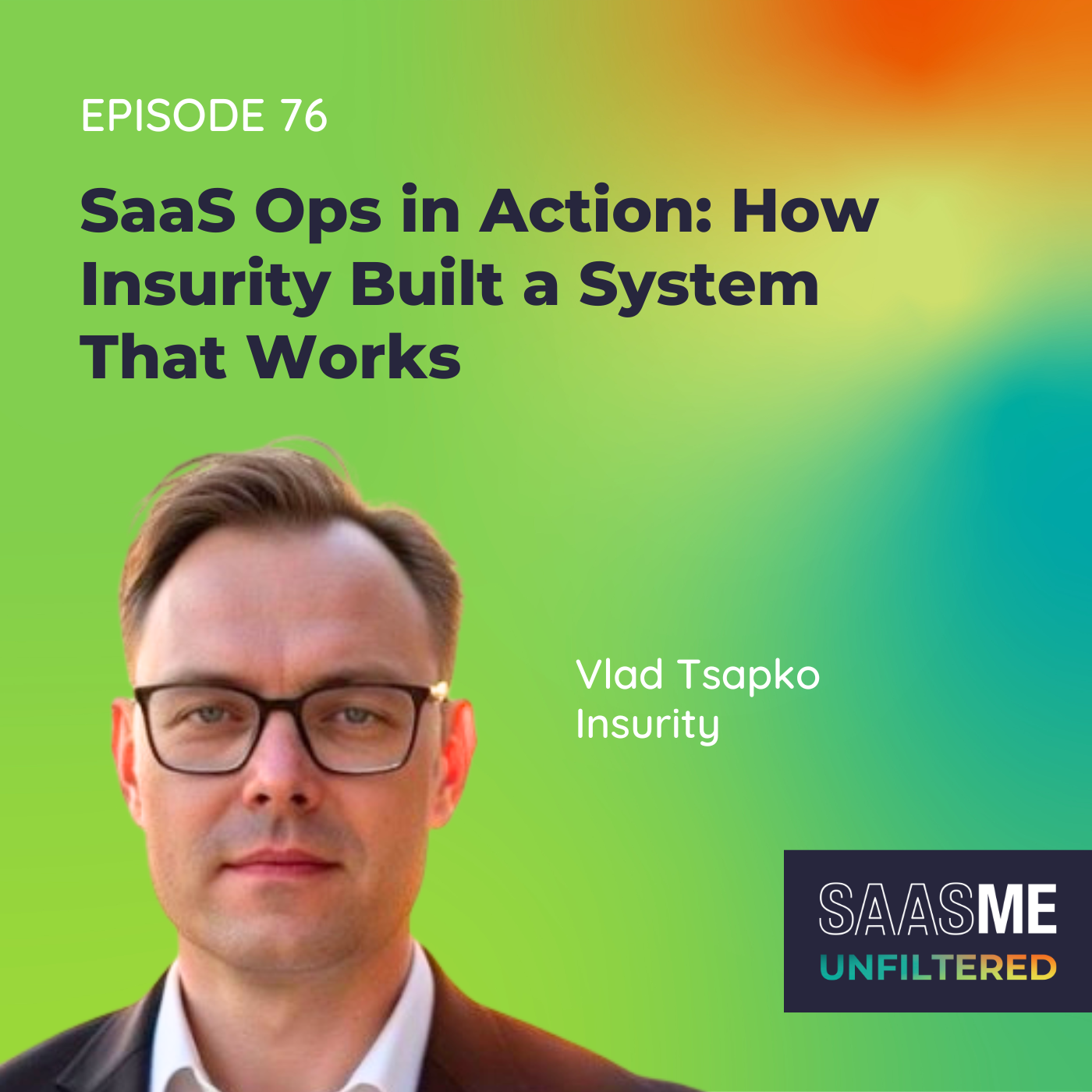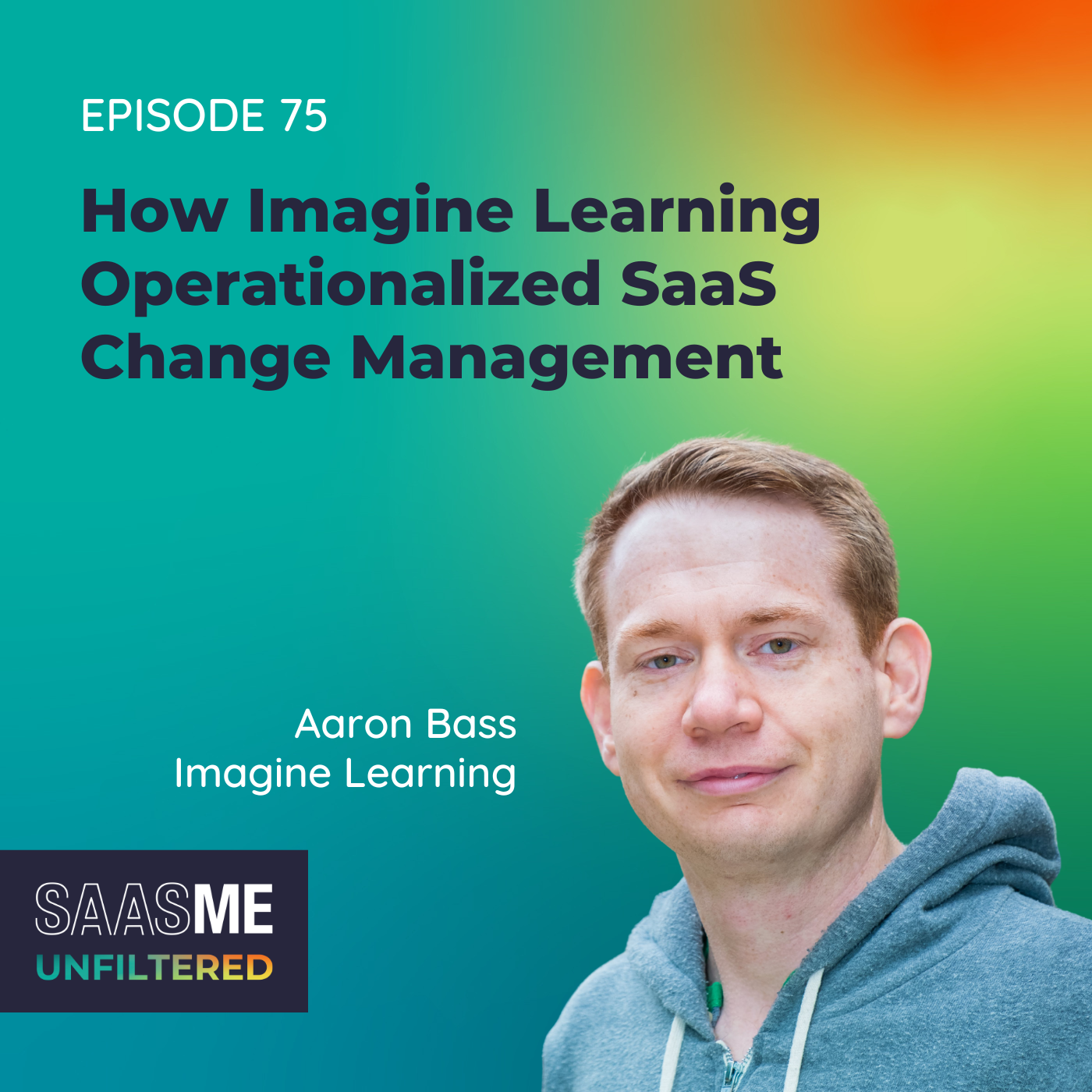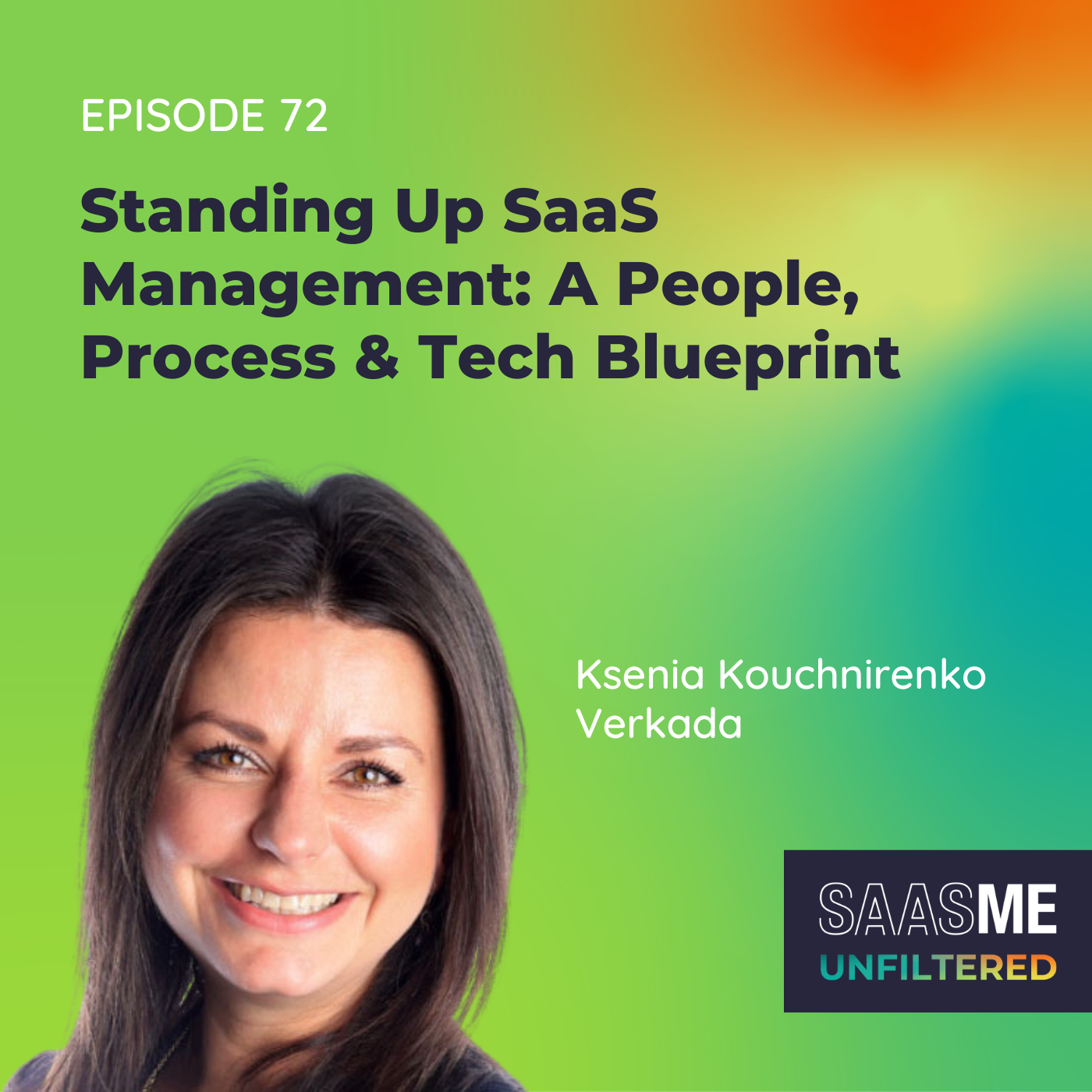3 SaaS Management Opportunities for 2024 with Matt Harney (Cloud Ratings)
- 0.5
- 1
- 1.25
- 1.5
- 1.75
- 2
Matt Harney: Short term, little underwhelming on the interest trends. Long term, I'm pretty bullish on AI and the durability of the trend. If you look at the ROI, companies disclosing ROI gains, it's around 55%.
Cory Wheeler: Hello, hello, and welcome to SaaSme Unfiltered, the SaaS Management podcast. The show with give it to you straight, real life advice from pros, knee- deep in SaaS every single day, SaaS management superheroes just like you. Hey everyone, welcome back to SaaSme Unfiltered. We're thrilled to be here and even more excited about the special episode we've prepared to kick off season four.
Meredith Albertson: Today, we've invited our resident SaaS expert and host of SaaSme Anything, Ben Pippenger on the show with Matt Harney. Matt is the founder of the software research analyst firm Cloud Ratings, and they're going to talk about the state of SaaS stacks today and the opportunities IT, software asset management, and procurement leaders have this year around SaaS management.
Cory Wheeler: If you've listened to the show before, you've heard about the many challenges, leaders just like you are experiencing around SaaS. The sprawl, exorbitant spend, shadow IT, security risks, the list goes on and on. Clearly there's a lot to tackle, but what's important to focus on in 2024?
Meredith Albertson: All right, we're going to hand it over to Ben and Matt to dive in and give you the scoop. Take it away, Ben.
Ben Pippenger: I think there is a big opportunity in front of IT, software asset management and procurement leaders in 2024, and that is rallying together behind SaaS management. I wanted to quickly just define what SaaS management is. I think there's different definitions out there for everyone. Here at Zylo, we think about SaaS management in three different ways. Number one, inventory, inventory management. Making sure you have full visibility and understanding every single SaaS application that exists inside your business, what it does, who owns it, and all the information about that application. Second is around optimization and primarily around license optimization. Really understanding what licenses you have running a process to optimize those licenses to pull back any waste or risk of licenses that are sitting out there unused. Then lastly is renewal management. Keeping track of and staying on top of all of those SaaS renewals that hit you, what feels like every single business day.
Ben Pippenger: Zylo's 2024 SaaS Management Index just came out and it sheds light on where IT, software asset management, and procurement teams, and specifically the enterprise needs to focus when it comes to those three areas, inventory licenses, and renewals. A little bit about the report real quick, this is our sixth year doing the report. It's based on over seven years of data and in that data there's about 30 million SaaS licenses and over $34 billion in SaaS spend that we're using to create the insights that are inside that report. It's a great asset if you're looking to benchmark your own program or potentially use it to justify getting a SaaS management program in place at your organization. Today I am thrilled to be joined with our friend Matt Harney. Matt is the founder of Cloud Ratings, which is a software research analyst firm that exists to allow organizations to make more confident, lower risk software purchasing decisions. A little bit about Matt. He's passionate about trail running. He's got two Pomeranians. One of his biggest passions is tracking all reports, charts and benchmarks across the business of software. So Matt, welcome, super excited to have you and to participate in our conversation today.
Matt Harney: Yeah, excited to be here and longtime fan of your SaaS Management Index. That's how we originally connected as organizations. Had your other co- founder on our podcast last year to discuss the report, and so fit to come back this year, and-
Ben Pippenger: All right, so a couple of things we're going to cover off on today. First, I'm going to start off with setting the stage on trends that we're reporting inside of that SaaS Management Index report. There's three trends I'm going to highlight. Trend number one is around decentralization of software buying. This is a trend that we've picked up on over the course of the last few reports, and it continues to be a trend. IT owns just 28% of the SaaS spend and only 17% of the applications in use within the enterprise today. That's down from 31% and 18% respectively, from the 2022 report. The rest of those applications are being bought by line of business leaders like your heads of sales, heads of HR, and then also being purchased by employees. Now let's talk about those employee purchases real quick. A lot of times organizations look at that and they say, okay, these employees are buying this software, they're expensing it. They may classify that as, what's called shadow IT. Now, what we've seen based on the data in this report is that our customers who this data is based off of, are tackling shadow IT heads on and they're really starting with the highest dollar shadow IT applications. So some proof points as to why we're seeing that. In 2022, individuals expensing apps sat at about 7% of the total spend for SaaS within their organization. In 2023, that number dropped 40%, compromising just 3% of the total SaaS spend. So we went from employees being responsible for 7% of the overall dollars being spent on SaaS, down to 3% of the total SaaS or dollars being spent on SaaS. Now, we compare that to the number of applications that employees are purchasing. This is where it gets a little interesting. So employee expense apps are down just slightly. So, previously they owned 37% of the application, so they were buying 37% of the apps, now it's down to 35%. That tells me that organizations are prioritizing resolving shadow IT issues, but the way they're going after it is the biggest apps. They're looking at the highest spend applications and they're working with employees to either cancel those subscriptions or maybe move them over to the enterprise agreement version that they purchased, or go through the right purchasing channels to buy those applications.
Ben Pippenger: So that's a good way to prioritize things, but I think it's also important to remember that for our second trend here is around risk. So risk is a big deal, spend is a big deal, but obviously risk is also a big deal when you think about SaaS applications that people are using, the data they're putting into those applications. There's a lot of unknown risks out there that could be damaging your organization. At Zylo, we launched a partnership with Netskope last year. With that partnership, we bring in Netskope data into Zylo in order to show their cloud confidence index and cloud confidence level scores. Those scores are based off of about 30 different data inputs in order to provide a scoring of the overall security of those different suppliers or vendors that you may be working with. We ran an analysis here to look at employee expenses and we were pretty surprised to see that almost two thirds of employee expensed applications had a rating of poor or low from Netskope's cloud index and cloud confidence level scores. So, while we are seeing customers be able to rid out those high dollar expensed applications, there's still a lot of expensed apps that exist, about 35% of a company's stack, and they bring a lot of risk into organizations.
Ben Pippenger: The third key trend I want to highlight right now is that stacks are shrinking, portfolio sizes are shrinking. Again, this is based off of our customers. So these are companies that have prioritized SaaS management as a strategy. So this is oftentimes one of the things that people want to do, they want to reduce spend and reduce the number of apps that they have. Really, what we're seeing is a recovery from bloat that occurred during the pandemic. So 2022, 2021, 2020, we saw a whole bunch of SaaS applications being purchased in order to accelerate digital transformation, give employees the ability to have a hybrid work environment and work from home and now companies are starting to reign it back. We saw that not only in our data here but if you read the news, 2023 was a really hard year for a lot of SaaS companies out there and we're showing the same thing. So a couple of stats here, 2021, the average amount companies were spending on software was $60 million a year. Then the average number of applications they had in their stack was 323 apps. 2022, we're down 16% to $50 million a year and 291 apps. In 2023, we're down to about $45 million a year on average and 269 applications. So, organizations are rationalizing, they are coming back and really figuring out what they actually need and don't need. But, one other really interesting stat here too is that in conjunction with our database index that we created, we also ran a survey to non Zylo IT leaders and software asset management leaders. That survey showed that 70% of IT and software asset management leaders are not doing anything about this at this time. So they're either using spreadsheets or legacy tools to track their SaaS estates. So, definitely still opportunity here for organizations to see some of the great success that our customers are. So I think all of this together presents a compelling case for why it's important and why you need SaaS management as practice and a strategy within your organization today.
Ben Pippenger: So over the next few minutes, Matt and I will be highlighting a few opportunities that you can take advantage of to reign this all in and really calm the SaaS chaos at your organization. So I'm going to go through three key opportunities. Opportunity number one, optimize your spend to fund innovation. Driving optimization is really at the top of the list of a lot of CIO's minds and priorities this year, but you counter that with the fact that they're facing flat budgets or really just small incremental growth against their budgets, and ever increasing vendor costs. Prices continue to rise for the applications and software that you're using today. So, how do you as a leader, free up money so that you can fuel innovation back into your business and drive new initiatives? Gartner says that by 2026, organizations will likely overspend on SaaS by 25%. So overspend by 25%. So there's got to be an opportunity there, if you're overspending by 25%, you got to be able to optimize. Many companies aren't doing this, so many companies aren't optimizing what they're spending with their big providers. We're seeing the real opportunity to do that with SaaS. In the SaaS Management Index this year, we show that 86% of spend is tied up in existing tools. So that means only 14% of the budget that you have, you're using to buy new technology. So there's a lot of money that you're leaving on the table and there's absolutely room to be rationalizing and optimizing in order to unlock some of that 25% within the 86% to invest into new innovative ideas and software. However, one of the challenges with SaaS management in general is that the process really is not well- defined. It's a pretty new practice, it's a pretty new set of capabilities and processes that you need to implement into your business, but the journey is that we're at that point in time when it's imperative that we're going to start to put some practices in place. So I like to look at, maybe there's another industry or another segment that's done something similar and where I've looked into is fin- ops and cloud management and cloud optimization. Really, when we look at what they've done five years ago, fin- ops didn't exist. There really was not a practice of how to do cloud optimization and now there is. Now most companies have visibility. They have the controls, they have the business process in place to manage their cloud spend effectively, which is great. So Matt, I'd love to open up the conversation here a little bit about what you've seen and how that happened. When it comes to the cloud and infrastructure, what trends have you seen over time going from when no one was managing it to what we're seeing now? How have you seen this mature over the years?
Matt Harney: Yeah, the shift in focus on cloud cost optimization really, really spiked, and that's where we got involved with tracking it actually on a monthly basis, just explosive growth. You were seeing it in the large company earnings calls, Amazon, Microsoft, Google, referencing it, as it was for the first time becoming a headwind where the growth trend for the hyper scalers was just massive. For the first time, as you were mentioning about things like FinOps and more discipline being applied to their cloud practices and their cloud spend. Part of the factor there is if you look at the scale of the bills and just the spend on cloud infrastructure, there's a real material savings and it's also very targeted. You can focus in on your Amazon spend and get real dollars out of there. We've seen analogs to Zylo like Vantage has been growing explosively, as you're able to get surgical and focus on specific client items in your cloud costs, and then also just do better on the blocking and tackling with your enterprise licensing agreements, your reserved instances. What we have seen though, is that wave has passed or at least plateaued a bit, and what we've seen in the back half of 2023 has been that optimization trend has flat lined a bit or plateaued. Still at a much higher level than it was three years ago, the overall interest levels in cloud optimization are high, but they've plateaued. We've seen that in the earnings for Amazon, Google, Microsoft, Datadog yesterday, Hashi, even Box to a certain extent. So I think there's some parallels. I think it would be an interesting discussion with you though, to compare what's happening on the cloud hyper scaler side with what you're seeing on the software side. Is it a slower process? Is it more complicated? Just given the nature of the app stacks, you're not talking about one or two vendors, you're talking about 300, in effect.
Ben Pippenger: Yeah, it's a great point, Matt. I mean, I think when you look at SaaS management and SaaS optimization versus cloud management an cloud optimization, they each have their own levels of complexity. You look at AWS, how many services do they sell? Hundreds of different services, they're all metered differently and they charge differently for all those things. So there's a lot of complexity that's all consumption based, real time usage. You're being charged for the things that you're turning on and turning off and how much of those things that you're using. So there's a ton of complexity there. You compare that to SaaS management and with SaaS management, you don't have the depth of the number of services that you're tracking for a single app, but you have way more apps. Our catalog of apps that we discover against is about 22,000 applications. Our system's trying to find those apps and then when we find them, we bring them in and give organizations the ability to then manage those applications and optimize them in our system but you got to remember, each of those apps are different companies for the most part. Each of those companies have different pricing models. Each of them have different ways to get the data that we need in order to look at what does usage look like, and then how do I optimize it based off of the contract that I have with that company? So there's just varying levels of complexity that you have with SaaS management that's different than cloud management. I think the other thing I'd say too is, and why I think fin- ops is so interesting and the fact that a business process has been established and our framework has been put in place that fin- ops practitioners can then pick up and then use within their company in order to drive the outcomes that they want to drive, which typically is responsible growth and visibility and cost optimization and charge backing and all that good stuff that they want to do with their cloud optimization platform. Similar framework for SaaS management isn't quite there yet. It's maturing and we're getting closer to that, but I think we need something like that in order for Marc Benioff to get on his earnings call and say, man, our growth rates have really slowed down because of everyone's optimizing their CRM licensing. That's just not, we're not quite to that point yet that we've seen with the big hyper scalers.
Matt Harney: Yeah, that's a really good point. Then just for me and for I think the audience, what inning is SaaS management in? I think maybe the hyper scaler style optimization's probably gotten to the third inning after this last cycle. What about you guys?
Ben Pippenger: I would put them a little bit farther than the third inning, I think. I think there's the fact that the growth rates have plateaued for those hyper scales, it makes me feel that there definitely is a lot of strong traction there for companies that are trying to do this. I think for SaaS management, it's still early. We started our company back in 2016, so a while ago, and the world has changed quite a bit and SaaS has changed quite a bit. We've delivered a lot of really good benefits and outcomes for our customers, but there is that putting a practice in place and then running a program within a company. It takes some work and companies have to be ready to prioritize that to make it happen. So it's still early, but there's a ton of opportunity. We look at just some of the stats I shared earlier just around how much waste there is within companies, how many unused licensing there are, how many apps are just out there in the wild, wild west. The opportunity is out there, it's just a matter of getting the programmatic elements in place and prioritizing them within your own companies. One of the stats that we have in the SaaS management index is around the cost per employee. So we look at employee size and we look at what the overall cost on SaaS is on a per employee basis. We saw that actually dip about 10%. A lot of the reason why we saw the overall app counts dip and the overall spend dip, when we look at that, how do you relate to that? Are you seeing broader trends there and overall spend from an overall SaaS perspective?
Matt Harney: Yeah, it's interesting to look at it from your data and then as it relates to the vendors who we track very closely. We have a real audience of investors who are hyper-focused on net revenue retention and expansion because it's such a critical driver to the value of these vendors. The thing that jumped out at me from doing the math from your report with the per employee spend down 14%, if you go look at the net revenue retention rates of best-in-class vendors like Datadog and Monday, who have a controllable element in it, relative to certain other SaaS applications. At peak they were running at 130% NRR, and that's dipped down to 112% range. That lines up perfectly with Zylos own per employee spend reduction. Now, the overall NRR contraction is a bit below Zylo. This quarter it's running around 8% contraction year over year. Zylo, the data I focused on your report was closer to 14%. Now granted, that means the Zylo customers are cutting more than the average user, and that makes sense. You have a more progressive, aggressive posture and you are ahead of the curve cutting, but that's what we're seeing on the vendor side and it's a real issue. Frankly, as a business owner myself, I've always observed these net revenue retention rates as, it's one thing to have a 5% 10% increase in a budget line item, but when you're talking 20, 25%, that gets into the range of unsustainable. There's some gamesmanship on how many license they sell you and built in growth into the expansion, but nonetheless, 25%. As you're talking about funding innovation and what's coming from existing spend, compare that to other departments across the company. 25% growth in a line item is pretty unacceptable or pretty hard to stomach. So that's just another way of looking at, just even as a small business owner and a research analyst firm, is we would have a hard time adopting to that.
Ben Pippenger: Potentially, I mean, that is maybe an indicator that optimization is broadly happening. I mean, the fact that those NRR numbers have shifted so much, companies are buying less. So I mean, is that from the bloat, from the pandemic, or is that an optimization effort that's going on? I don't know if it may be hard to judge, but essentially it's happening more frequently than you'd imagine.
Matt Harney: Yeah, and some of our broader research on the pandemic type transformation is, there was a lot of pull forward under an umbrella of digital transformation that wasn't always supported. There were a few categories where the environment truly shifted from video conferencing, certain virtual event apps and the like that had a fundamental shift. But there were other areas that there's this expectation that the pandemic fundamentally changed demand for DocuSign. Well, it really didn't. At the end of the day, DocuSign has a pretty consistent path of adoption and the pandemic should not have changed that.
Meredith Albertson: If you're not unlocking the full value of your SaaS, what are you doing? There is no denying it. SaaS is mission critical to your company's growth and success. As the number two operating expense for most organizations, it's your biggest opportunity to save money and drive efficiency. The time is now to do something about it. Join me and your fellow IT, SAM, finance, and procurement leaders at SaaSme. SaaSme is the industry's only dedicated SaaS management event where you can sharpen your skills, hear from your peers, and learn how to unlock value and responsible business growth through smarter SaaS management. Register today SaaSme. com. That's S- A-A- S- M- E. com.
Ben Pippenger: All right, well I'm going to jump in here to opportunity number two. I think we can probably spent a while talking about each of these. Matt, I'd love your insight here. Opportunity number two is around improving SaaS governance. So I hit on around the decentralization of SaaS, so IT owning less, the business owning more, and that continues to be the case. So, IT teams are not buying as much software as they used to. Now, the opportunity here for IT teams though is to really embrace this, embrace the decentralization of SaaS buying and really to make sure that the proper governance and controls and processes are in place, as apps under the business. Now, why is that important? Why should IT teams be doing that? Four key points here, number one, stop the sprawl. A great redundancy check is as apps are being requested to be bought, let's check against what we already have and see if we have a capability that exists for a tool we already use and suggest that one versus buying something new. Second would be to ensure that any app that is entering your company has been vetted by your privacy and security team. Remember, two thirds of those apps that are being bought by employees have a poor or low cloud confidence level. So really important that that's part of your process. Number three, making sure you're buying software the right way. Ask yourself as purchasing is happening, does it make sense to buy this maybe through a marketplace to leverage retiring your EDP or other commitments? To go through a reseller, if you've got a reseller engagement set up to support that application, or even maybe through your enterprise agreement if that's in place as well. Then lastly, this enables IT teams to understand if the app can be supported through their existing shared services, like potentially getting it set up with your single sign- on or your identity governance platform or through your help desk if you're going to be supporting that application that way. So governance is really important and really it's something that every company should be thinking about when they think about SaaS. Every company is going to be different though. So really, how should you tackle this and how should you think about this? We have a great customer, Netflix, and they're a great example of a company that really has a pretty forward thinking approach when it comes with governance. They call it freedom and responsibility. Matt, you've covered that in one of your previous SaaS letters, which is your email newsletter. Netflix's approach really starts with their culture, which is a key factor, determining the governance approach for them. What's your perspective here? How do you think about governance and how do you tie that back to maybe what Netflix has done and take some inspiration from that?
Matt Harney: Yeah, and part of the reason we covered is that slide deck on their culture has been surprisingly popular. When you think about how content tends to disappear, particularly business content, it's not incredibly durable and it's remained popular, like 17 million views. The reason we looked at it was it's remained popular and we also leveraged some research from Forrester and there's demographic changes that have occurred naturally since 2009, that millennials and Gen X are 21% more inaudible of having freedom and responsibility in their day- to- day role in a company. They're less willing to be told what to do, and that makes sense. We also looked at it through a lens of AI because this whole concept of freedom and responsibility is going to have new dimensions to it around reputation. You've seen in the news, lawyers citing cases that did not exist due to hallucinations, and it's just horribly embarrassing. You can see possibilities of that in any type of business. Security risks, in terms of these small, new emerging vendors handling sensitive information or just adding new security vectors into your company. Then even ethically, if you're a copywriter or content marketer at a company and you have AI do 100% of the work for an article or a press release. What's your ethical obligation to disclose whether you did it or AI did it? And if someone was there fulfilling the role of overseeing things. It's going to add these new dimensions, which that we haven't considered before. So we wanted to take a look at it and this Netflix framework has been excellent and we've noticed your freedom in a framework and how you guys approach it and we admire that perspective.
Ben Pippenger: Yeah, I mean, I think with back to this opportunity here around decentralization, I mean that's exactly what it is. It's, businesses need to enable their employees and their business line leaders and their leaders across the company to find the tools that they need to get their job done that are going to best serve them, while at the same time, making sure the guardrails are being followed for the business. You're not introducing productivity loss or risk or overspending as a result of it. That's really what the Netflix mantra is here. We spoke to Lindsay Stokes, who is their IT asset program manager over at Netflix. She was on SaaSme Unfiltered last season. She defined freedom and responsibility in the context of IT as, what we're trying to do is more emphasis on the responsibility side. It means educating users and letting them understand what's available to them, publishing what's out there, and then even making suggestions. So that truly is freedom within a framework. It's enabling the end users to do what's right while having those controls in place. All right, let's keep rolling here. Opportunity number three, and I know this is one that's a passion for you, Matt, is around AI and adopting AI. We've been talking about AI for a long time now it feels like, it's been everyone's favorite topic for, I don't know, 24 months or so, because it's so transformative and it's so impactful for how companies get work done today. What we've seen is that a lot of companies are still really scrambling to figure out their stance on AI. What controls should they have in place with AI? I mean, you mentioned around the governance side, how do you think about enabling people to use AI within your business in a responsible way? But at the same time, what we're seeing in our SaaS management index this year is that companies or employees are taking this into their own hands. For the first time in 2023, we saw AI tools pop into the top list of most expensed applications with both ChatGPT and Open AI's API being listed within the top list of expensed applications. So even with controls and things, employees are trying to figure out ways to use these tools to be more productive and get more done. So cloud ratings, Matt, your organization recently put out the AI interest index to examine trends in user interest in AI tools. We started to see a shift, an upward trend at the beginning of last year. What are you seeing though, from a high level? Is the demand for AI really living up to the hype?
Matt Harney: I would characterize it as the demand has actually been a bit underwhelming, when you look at it, particularly for all of the hype. You would expect that the demand would be continuously accelerating through word of mouth, and it's actually had a peak middle of the year and declined. Now, there's been some upturn in things like Microsoft Copilot, but of course a lot of this is driven by product announcements and the like. But very similar to what you've seen at Zylo, that these AI apps really lend themselves to being individual purchases and productivity enablers and we look at those, we call them atomic apps, like personal productivity in areas like copywriting or podcast editing, video tools, but far, far less on the compound enterprise apps that take together individual productivity tools and make a more sophisticated app that fits within an enterprise. So short term, little underwhelming on the interest trends. Long term, I'm pretty bullish on AI and the durability of the trend. If you look at the ROI like companies disclosing ROI gains, it's around 55% gain across a broad mix of industries and functions like customer service, supply chain, data accuracy, quality assurance. When you have that type of gain and automation, it's just so powerful and it's going to take a while for these examples to figure themselves out. But long term, I'm excited. I think near term, if you feel like you're behind, a lot of people are behind because this is not easy to figure out.
Ben Pippenger: Yeah, it's not easy. How are you responsible about it as a business? How are you enabling your employees to be responsible themselves as well? We've previously here at Zylo related AI to shadow IT, apps that employees are out buying outside of the purview of any controls or governance in place. Actually, have a similar recommendation for AI tools where it's, make sure that you're providing the right education, the right enablement for your end users to know what's acceptable and what's not acceptable, and how to use those tools. Then make sure you have the right process in place to monitor what's going on. I mean, that's the other part too, is you don't want to be stuck surprised at some point if someone's using something you didn't know about or buying something you weren't aware of. So make sure that once you've defined your own standards for how AI needs to be used within your company, that you then got the proper governance and controls in place to monitor what's going on. So that if someone's not following the control for one reason or another, you're able to go remediate the issue before it actually is a big issue for you or your organization. So, all important steps in the process. I think a good opportunity as we think about some of the data that this report is shedding a light on, around the rise of AI applications and what organizations need to be doing and how they should be thinking about this to make sure they're as safe as possible. So thank you, Matt, and we will catch you next time.
Cory Wheeler: Did you enjoy the episode? Pass it along to your friends, subscribe to get notifications for the latest episode, share your favorite takeaways, and join the conversation on social media using hashtag SaaSme Unfiltered.
DESCRIPTION
In 2023, organizations spent an average of $45M on SaaS. Yet, $18M of that is wasted. This isn’t chump change – it’s your second largest operating expense. That’s why we’re calling 2024 the year of opportunity for software management.
Between rampant license waste, heightened security risks, and surplus of renewals, it’s hard not to feel like you’re treading water. Add in rising vendor costs and tight budgets, and you’re soon gasping for breath.
In this episode, Zylo co-founder Ben Pippenger and Cloud Ratings founder Matt Harney examine trends from the 2024 SaaS Management Index and how IT, Software Asset Management, and Procurement leaders overcome these headwinds and come out on top.
Today's Host

Ben Pippenger

Cory Wheeler

Meredith Albertson
Today's Guests

Matt Harney








